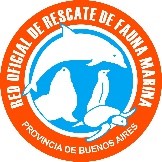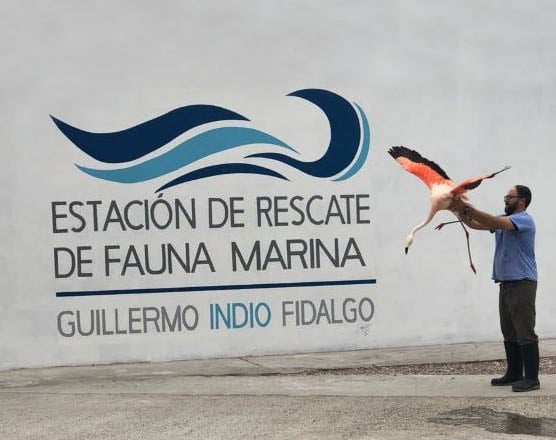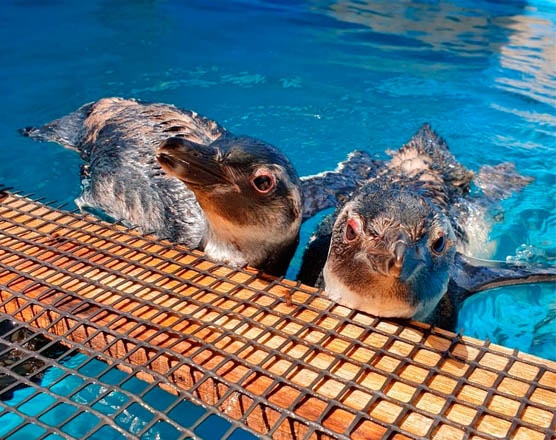Guillermo Indio Fidalgo Marine Wildlife Rescue Station
The Guillermo “Indio” Fidalgo Marine Wildlife Rescue Station (ERFAM), was born in April 2017 as a result of a strategic alliance between the company Lanchas del Sur, the Port of Bahía Blanca Management Consortium and local professionals with extensive experience in the management and conservation of biodiversity.
Among the latter are biologists, veterinarians and rangers, who have been working on the conservation, assistance and recovery of marine animals for several years, both in Argentina and abroad.
In the absence of wildlife rescue centres in the region that will be able to contain the demand for marine animals that frequently appear along the coast, and the need for a space for their assistance and recovery, arises this possibility of joint work that finally shaped the station.
However, in addition to this primary attention to wildlife, ERFAM also seeks to address the environmental problems faced by our seas and their relationship with the human species, developing a non-formal environmental program education. In this last aspect, we have planned the development of a space to receive visitors that, in addition to bringing the community closer to our environment, is inserted as an ecotourism alternative that articulates with the local and future offer on the coast of the estuary of Bahía Blanca.
The rescue station is officially part of the Marine Wildlife Rescue Network of the Buenos Aires Province.

Example of the Southern Flamenco (Phoenicopterus chilensis) rescued, attended and released at the Rescue Station (April 2018).
The biologist and director of the Rescue Station, Pablo Petracci, performing bodybuilding exercises during his rehabilitation. Like the human species, after prolonged inactivity, the rest of the animals must also re-strengthen their muscles before returning to the wild.
Southern flamingo is the only one of the three species of flamingos that inhabit Argentina that can be spotted in our region and, although it is quite common and has a wide distribution, is categorized as a vulnerable species due to its very high concentrations in a few places during the breeding season.
Magellan penguins (Spheniscus magellanicus) receiving care and hydrotherapy at the Rescue Station (March 2019).
After reproduction in Patagonia, Magellan penguins migrate to the estuary of the Río de la Plata, Uruguay and southern Brazil, where they will spend the winter.
Many juveniles, due to inexperience and lack of food, separate from the group and end up on our shores. The state of dehydration and malnutrition weakens your immune system and they become more sensitive to infections by parasites, viruses and bacteria, so they often become very critical.
In our country they are included among vulnerable species.
Release by ERFAM and Lanchas del Sur S.A. staff from a 5-year-old green turtle (Chelonia mydas) on Monte Hermoso Beach, in front of hundreds of boys from different educational institutions (March 2019).
The green turtle is the most frequently found and most threatened species of the three species present in the waters of our estuary.
In most cases, these records are due to their accidental capture in fishing nets. Thanks to the cooperation of artisanal fishermen who report these incidents, turtles arrive at the Rescue Station, where their health status is monitored and, if they do not require extra attention, are promptly returned to the sea.
All sea turtles are classified internationally as threatened.
Another species very sensitive to bycatch in fishing nets is the Franciscan dolphin (Pontoporia blainvillei), considered internationally as threatened and declared a Natural Monument of the Province of Buenos Aires.
Petrel Giant of the South (Macronectes giganteus). Rescued at the Rescue Station (June 2019).
Petrels are large gliders that exceed two meters when their wings are extended. They nest in colonies on sub-Antarctic islands, Antarctica and Chubut, but after reproduction they live on the high seas.
Our area is mostly youthful during the winter and is often more frequent when there are strong southerly winds. Several individuals have been found with health problems.
One of the main conflicts, for both petrels and albatross, is the accidental catch by longline fishing, fishing lines with thousands of hooks where some birds are hooked and die.
Species of this group can live up to 50 years, reaching their sexual maturity only at 10-15 years; they lay one egg per season and have a strong tendency to mate for life.
All of these characteristics make high mortality of adult individuals a big problem for the future of their populations.
Magellanic penguins (Spheniscus magellanicus). Assistance and rehabilitation (February 2020).
To date, more than 300 individuals of different species, many of them threatened with extinction, have received attention at our facilities.
Its rehabilitation and reintroduction is possible not only for our work but also for the cooperation and commitment of the region’s artisanal fishermen, park rangers and our team of volunteers.

Usurbil, a ship with a lot of history
Usurbil, a ship with a lot of history
In April 1982, during the Falklands War, was used as a camouflaged spy ship under its fishing appearance. In March 1993, while at the port of Engineer White, a fire destroyed him. Then, in January 1999, he was taken to one of the internal canals of the local estuary where he was run aground. It is considered a Historical Monument. I want to visit it!!
The Usurbil Odyssey
Ecotourism
Navigations to combine in front of port: Usurbil, Cuatreros, Isla Bermejo and other destinations.
Contact Us
Almirante Brown 3774, Ing. White, Bahia Blanca, Bs. As., Argentina (B8103FHN)
+54 (0291) 457-1306
+54 (0291) 457-0949
Emergency responce:
+54 291 642 4112
+54 291 441 9078






